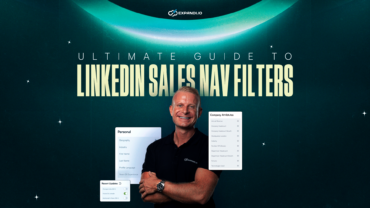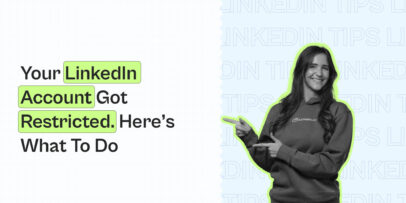Linkedin engagement pods: all you were embarrassed to ask

If you’ve encountered someone’s LinkedIn post with several comments and likes within a few minutes of posting, and considering they’re not an influencer, chances are they’ve used an engagement pod.
And we can’t really blame them. The LinkedIn algorithm has been a tough nut to crack.
The purpose of posting on LinkedIn can mean different things to different people or businesses. For some, it’s to get inbound leads, while for some businesses, it’s to get traction in their newly opened job position.
Regardless of the reason, people have been seeking all kinds of ways to get maximum engagement on LinkedIn.
That’s when LinkedIn engagement pods come in handy. But do they come at the price of risking an account ban?
This article will take you through:
- What LinkedIn and engagement pods are all about.
- Risks associated with creating a LinkedIn pod.
- Safer alternatives to engagement pods for boosting LinkedIn organic reach.
- Tips for risk-free LinkedIn engagement.
Let’s begin.
What are LinkedIn engagement pods?
A LinkedIn pod, or the LinkedIn engagement pod, is a group of LinkedIn users who’ve agreed to interact with each other’s posts by commenting on them, liking them, or sharing each other’s content.
Think of it as a strong community of users agreeing mutually to increase each other’s engagement on LinkedIn.
Understanding the mechanics of liking, commenting, and sharing and their impact on content visibility
Social media algorithms favor content with high engagement. But what’s engagement all about?
Social media content engagement is a combination of users’ likes, comments, and shares on your post – leading to more organic reach.
LinkedIn’s mechanics of rating content as engagement-worthy are more content-focused than other sites like Instagram or Facebook. Meaning LinkedIn favors conversations, determines content topics your followers may find interesting, and prioritizes content by factoring in past interactions.
The bottom line is as more and more users like, comment, or share your posts, LinkedIn is most likely to boost your content.
How do LinkedIn engagement pods operate?
LinkedIn pods can be broadly classified into manual, automated, and LinkedIn-specific pods:
1. Manual LinkedIn engagement pods
A manual pod involves people (often from the same industry) joining a group on platforms like Telegram, Slack, Facebook, WhatsApp, etc., with the intention to engage with each other’s posts.

Engagement pods on Facebook
Engagement could be of any form, for example, sharing posts, commenting on something insightful, or just liking them so it reaches a wider audience. Doing so is said to ‘fool’ the LinkedIn algorithm into believing the content is high quality and interesting.
2. LinkedIn-specific engagement pods
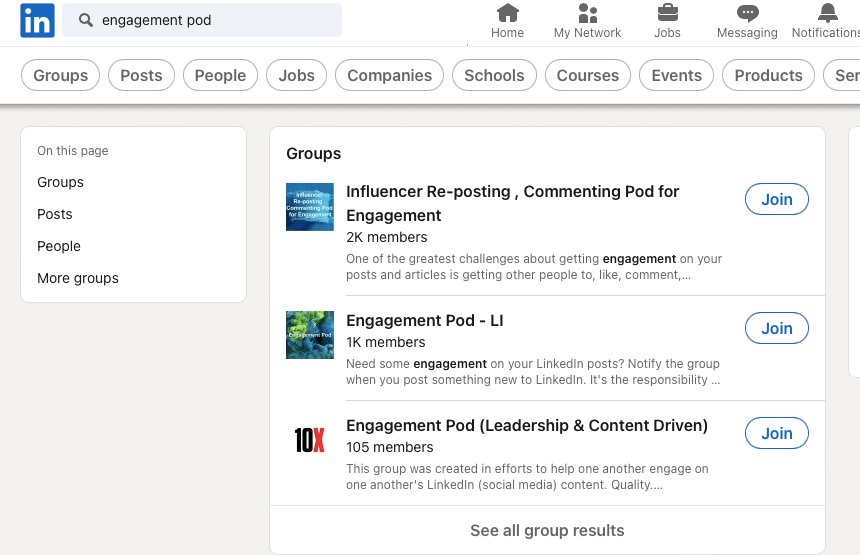
LinkedIn-specific pods are LinkedIn groups specific to creating pods for a particular industry. You can easily look for them in your LinkedIn search bar by typing in your industry followed by ‘engagement pod.’
For example, if you’re in the SaaS industry, your search may look like: ‘SaaS engagement pods for LinkedIn.’
3. Automated LinkedIn pods
If you dread reaching out to people for engagement, you can now hand off LinkedIn engagement to third-party tools.
Tools like Lempod and Podawaa are tailored to automate LinkedIn engagement pods and boost your organic reach.
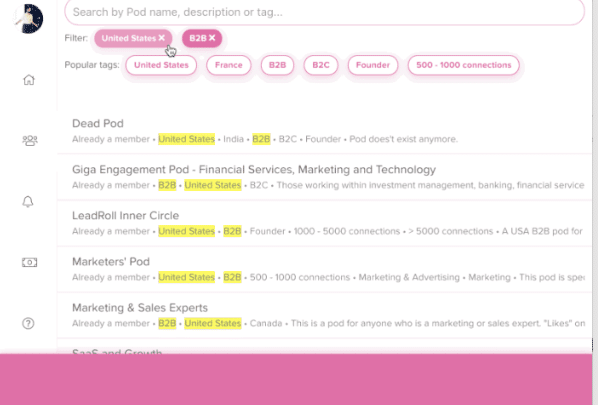
They are Chrome extensions letting you join the right engagement pods for LinkedIn, just like manual pods. However, instead of reaching out to people manually, you can add your posts to the app, where other members will automatically engage with them.
Benefits and drawbacks of engagement pods
Requesting for engagement or relying on automated engagement seems harmless. Wrong! There are times when engagement can do more harm than good.
Let’s discuss the pros and cons of each engagement pod to understand better:
1. Manual LinkedIn engagement pods
Benefits:
- Engagement comes from credible sources, as most manual pods are industry-specific.
- Insightful comments from users familiar with your niche can boost organic traffic and inbound leads.
Drawbacks:
- More effort and time are spent manually commenting on others’ posts. Failing to which can bring you lesser engagement as users wouldn’t pay back the favor.
- You may receive insufficient comments and likes, as pod members’ availability is not guaranteed.
2. LinkedIn-specific engagement pods
Benefits:
- You can expect high-quality engagement from those niche-specific members since you share a similar audience with your LinkedIn group.
- It makes it easier to share your posts with the group and request engagement, as the pods are present right on LinkedIn.
Drawbacks:
- Solely relying on a LinkedIn group to fetch your engagement is not a great idea. Most users, or the pod itself, may be inactive.
3. Automated LinkedIn pods
Benefits:
- Saves time and effort, thanks to automated engagement.
- Sky’s the limit to joining pods, receiving comments, and likes.
Drawbacks:
- Lack of insightful user comments. For instance, ‘Thanks for sharing this post!’ is a low-quality comment and is pointless.
- A lack of control over engagement. You may receive comments or likes from audiences outside your industry.
- You could risk LinkedIn marking your posts as ‘spam,’ flagging your profile, and devaluing your future content.
Hootsuite conducted research on LinkedIn engagement pods to find their differences:
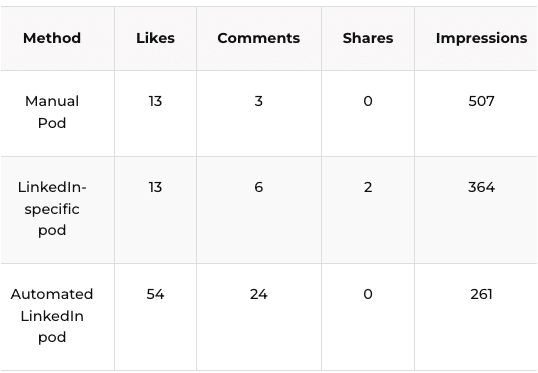
As you can see, the automated one seems to be the perfect LinkedIn pod to fetch more likes and comments.
However, since they lack high-quality comments, the manual pod is a more organic and authentic way to attract engagement.
LinkedIn’s approach to combating engagement pod abuse
LinkedIn’s algorithms are custom-made to control spam and tackle pod abuse. They are constantly upgraded to display high-quality content to their users.
Here are a few ways LinkedIn tackles misuse of engagement in the name of pods:
- Frequent engagement with accounts not in your first-degree connections can put your profile under LinkedIn’s radar.
- Engagement on company posts from users not following the company page can risk account flagging.
- Algorithms detect large pods with many posts to check for credibility. In the end, members could be held liable for misuse of pods.
- Engagement pods detected by algorithms get their posts often ghost-banned.
LinkedIn’s official page on community policies states, and we quote “Create original, professional, and interesting content to gain engagement. Don’t do things to artificially increase engagement with your content.”
Risks and pitfalls of engagement pods
Let’s discuss some hard-to-ignore risks and pitfalls of using engagement pods for LinkedIn growth:
1. Increased likelihood of LinkedIn account bans
As mentioned, LinkedIn algorithms scrutinize posts receiving out-of-the-ordinary engagement and flag posts as spam, or worse, banning accounts with no way to recover them.
So ask yourself – would you risk losing your account in an attempt to receive pointless engagement on your posts?
2. Reduced credibility and authenticity
If you want to get inbound leads on LinkedIn, riding on low-quality comments on your posts will do you no good.
And despite having an optimized LinkedIn profile, you risk losing skills and credibility. Also, most public pods lack safety measures. Engagement from such unauthentic sources can hamper your organic reach and growth.
3. Negative effects on personal branding and networking
Most professional individuals rely on LinkedIn to build a strong personal brand and network with others in their niche. And it takes less than a minute to lose what you’ve built.
Imagine you’ve just connected with a potential lead, only for them to find that you receive spammy, irrelevant comments on your posts. They may lose interest in you and drop the idea of taking the conversation further.
4. Content quality control
You will have no control over the quality of comments on your posts – which is a major minus.
Ultimately, your posts may lack quality since you’re confident of receiving engagement regardless of the content’s quality.
5. Unfollowing contacts
It won’t be too long for your first-degree LinkedIn connections to notice abnormal engagement on your posts and eventually unfollow you.
6. Time suck
Pods can range between 100s to 1000s of members, with no security or safe engagement training. And even if you share a similar audience, it’s not guaranteed that the members are active in these groups.
And engagement is a never-ending loop that consumes most of your precious time. Members expect you to return the favor by interacting with their posts, even if they are irrelevant to your domain.
Alternative strategies for boosting LinkedIn engagement
Stop worrying if you’re overwhelmed with engagement pods’ associated risks. Pods are in no way the ‘end game’ to boost LinkedIn engagement and grow your personal brand.
So we have three alternative strategies for you to shine on LinkedIn with zero risks:
1. Leveraging your network without pods
Forget LinkedIn engagement groups. You may already be a part of several internal groups consisting of team members, industry-related interaction groups on Slack, and company WhatsApp groups – you name it!
Leverage your existing network to boost engagement on your LinkedIn posts. Since they already know you and share a similar audience, chances of reaching a wider audience are at an all-time high.
For example, we have a separate chat in Discord named ‘Engagement-pod’ to get internal support from our teammates:
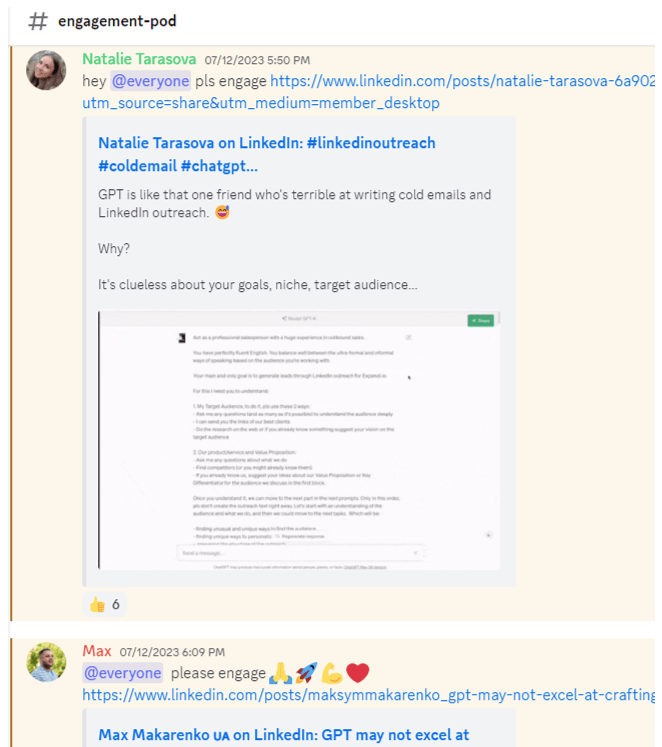
2. Building genuine relationships with colleagues and connections
Your first-degree connections on LinkedIn and colleagues are your ultimate confidants. You can rely on them to engage with your posts. And don’t forget to reciprocate by engaging with their posts as well.
Start sending personalized messages to your connections on LinkedIn. Compliment them on their unique insights and share how you resonate with their posts.
Don’t limit yourself to your existing connections. Reach out to others, such as second and third-degree connections in your industry, and start interacting with them to widen your network.
Did you know you could automate this process?
Using Expandi’s Smart Sequences, you can send customized connection requests, follow profiles, like posts, endorse skills, and so much more using a simple automated workflow. You’re free to add any number of steps and custom conditions to build genuine connections from scratch:
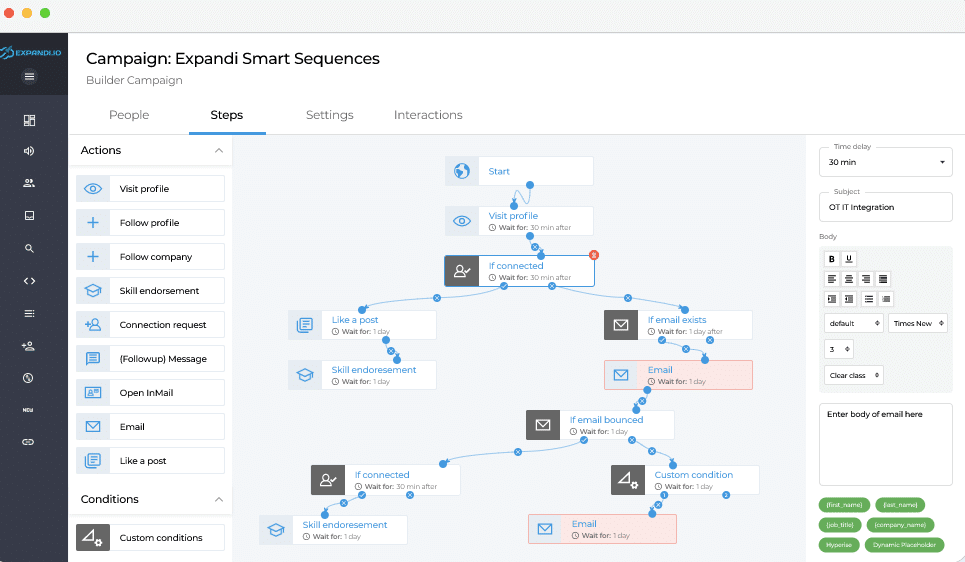
3. Content optimization and utilizing LinkedIn features
At the end of the day, remember that LinkedIn is just another social media platform. And a majority of rules, such as optimizing content and profile, posting at the right time, writing crisp posts, etc., apply to LinkedIn, too.
And no doubt, optimizing your LinkedIn content is a sure-shot way to reach your target audience and get engagement without risking your profile.
Here are some awesome LinkedIn features you can tap into for an engagement boost:
- LinkedIn polls – Polls are easy to interact with. It’s a great way to collect your audience’s preferences, pain points, etc.
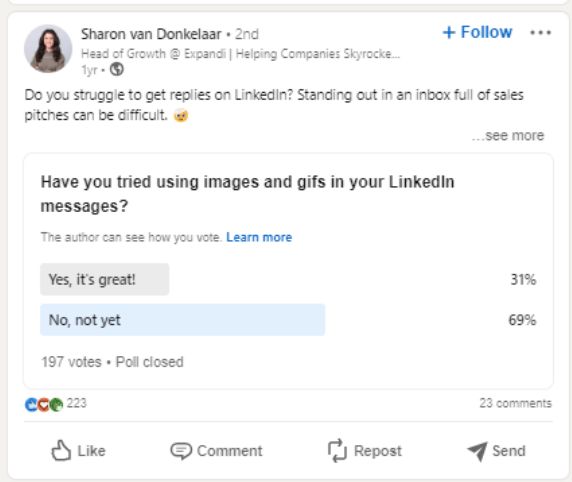
- Video meetings – You can host a one-on-one meeting right on LinkedIn. Use this feature to connect with a potential client or an acquaintance.
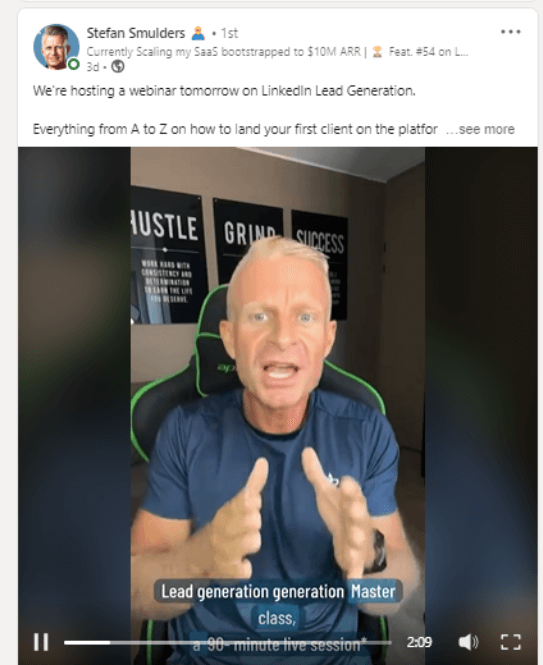
- LinkedIn Live – You can broadcast Live from your profile or an event. Going Live is a great way to connect and re-engage with followers. You could also create an event and invite your followers to join the Live.
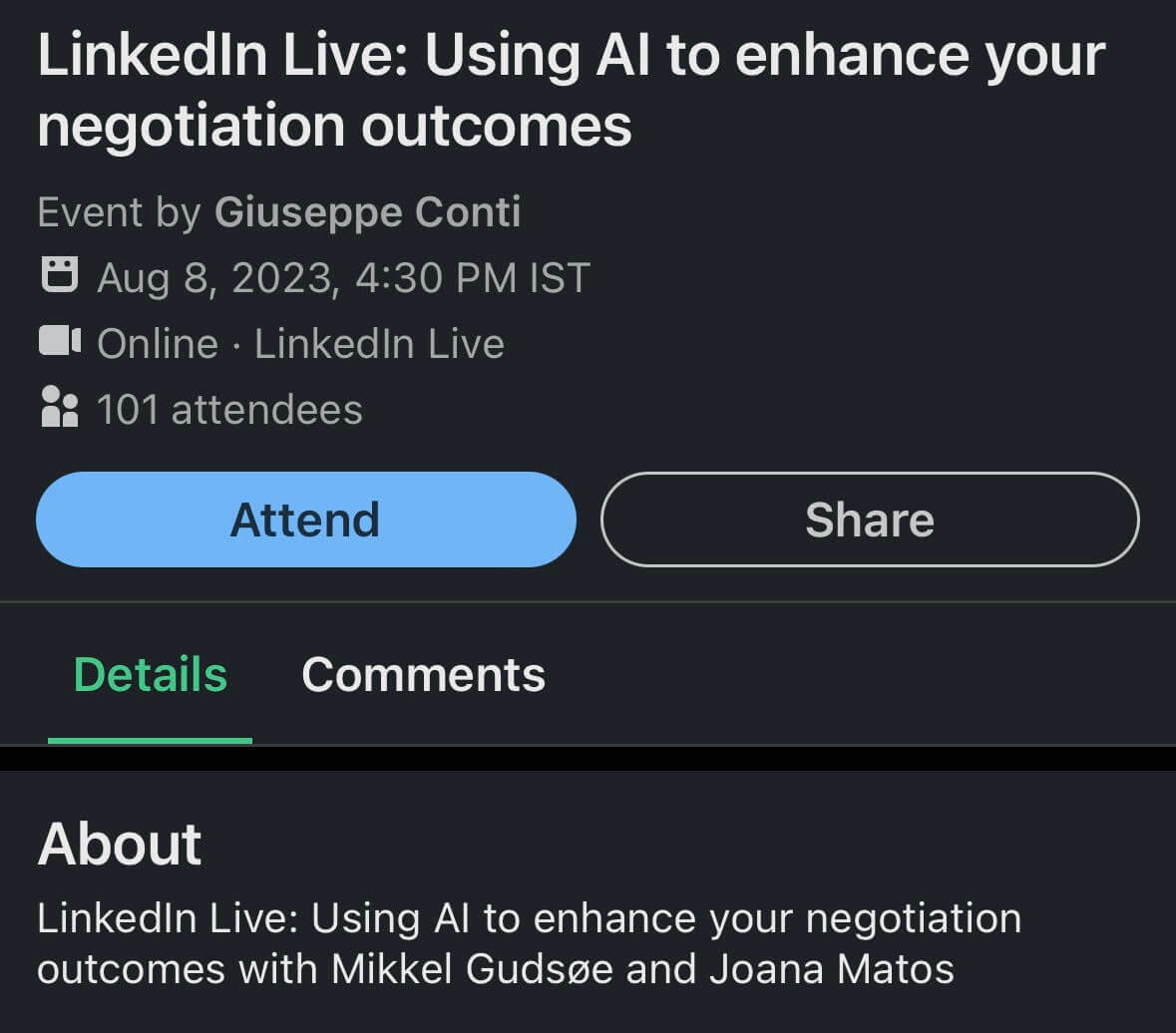
- Creator mode – Since you will create a lot of relevant content on LinkedIn, ensure you switch your account to Creator mode. Doing so lets LinkedIn push your content to others and helps grow your personal brand.

Tips for safely increasing LinkedIn engagement
If you’re not the kind that risks your personal brand for LinkedIn engagement, we have just the right tips and best practices for you.
Best practices for growing your LinkedIn presence
-
Be a value-add
Add value to your followers by sharing authoritative content and insights. It helps you build expertise in your field. Eventually, your followers and potential clients picture you as a go-to person and thought leader.
-
Post frequently, but not too frequently
Posting too frequently, for example, 5x a day, can tire your followers. You could stick to 1x a day to catch their attention better.
-
Join niche-specific LinkedIn groups
Engage with LinkedIn groups belonging to your interests or industry. Connect with their members to establish a rapport.
Pro tip: Use Expandi’s Smart Sequences to send connection requests to users of a mutual group automatically or if you’re attending an upcoming event:
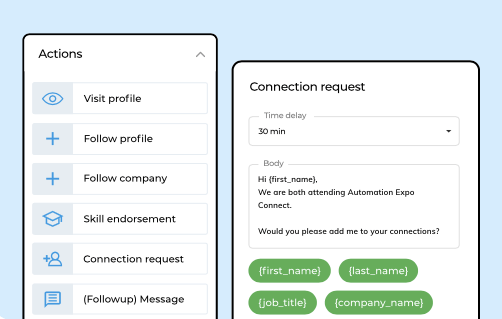
Your LinkedIn profile should be well-optimized with relevant keywords, an up-to-date skillset, a high-quality cover picture (stating your services or skills), a compelling headline, and a clear profile picture.
Highlight skills and use keywords in your headline, skill section, and cover picture to make it easier for potential clients or colleagues to find you.
Engaging with relevant content and users
Want to grow organically on LinkedIn without risking the use of engagement pods? Here are some tips we’ve collated for you:
- Always stay relevant to your audience’s interests to attract more genuine engagement.
- Interact with posts of your target audience and others in your network by liking them (the bare minimum), adding insightful comments, or sharing them. This way, LinkedIn prioritizes your future posts on their feed.
- Figure out the best time to post on LinkedIn – ideally between 9 to 11 a.m., as most professionals are getting ready for their day.
- Use strategic keywords. If your post is about ‘sales enablement,’ ensure you use its variants – but don’t overdo it.
- Avoid adding outbound links to your posts. It confuses readers, and LinkedIn has stopped prioritizing posts that do so. You can instead add them to your comments.
- Connect with your target audience by sending personalized connection request messages instead of generic or no messages. This way, LinkedIn understands you know each other and prioritizes your posts on their feed.
Maximizing the impact of your posts
What makes LinkedIn posts impactful? Below are some simple techniques we’ve gathered post researching trending content:
- Keep the text simple and conversational. Avoid using jargon-heavy language.
- Imbibe storytelling into your posts.
- Open with a strong hook.
- Leave sufficient white spaces between short paragraphs or sentences for better readability.
- Don’t shy away from using images and videos.
- End every post by asking a question to invite engagement.
- Use copywriting formulas like AIDA or PAS.
- Test follower engagement with different content formats, for example, videos, carousels, text-only posts, expert quotes, etc.
Wrapping up
LinkedIn engagement pods can offer you a quick route to being visible and fetching engagement. But often, engagement quality and profile security are compromised.
So look for safer engagement pods, for example, groups within your team or company. This way, you have better control over the quality of comments and likes your posts garner. And most importantly, the LinkedIn algorithm doesn’t smell something fishy.
Using a tool like Expandi, you can tap into its wide range of features tailored for LinkedIn outreach. Hyper-personalize connection requests, automate follow-ups and likes and get more leads the organic way.
Try for free – sign up for the 7-day free trial now!
You’ve made it all the way down here, take the final step
